
No Limits
By Sheryl Nussbaum-Beach
February 15, 2008
URL: http://www.techlearning.com/showArticle.php?articleID=196604995
from Technology & Learning
Digital technologies have opened up unimagined environments for teachers and students. We take a look at best practices representing systemic change.
 Studies show that students using new media are more engaged in the classroom. |
The speedy evolution of technology over the past 30 years has often outpaced our ability to use it to transform teaching and learning in real and meaningful ways. Much of that time we just tried to keep up, with new technologies often simply bolted onto traditional curriculum practices. However, today, with three decades of digital experience under our belt, the time is ripe to begin instituting true change.
George Hall Elementary
Inner-city George Hall Elementary, in Mobile, Alabama, is one of the state's 40 schools participating in the Alabama Best Practices Center's 21st Century Learning Project. The project helps teachers gain the skills needed to prepare students for a world dominated by digital technologies.
At George Hall, where almost 100 percent of students qualify for free lunch, Principal Terri Tomlinson estimates that less than 15 percent have high-speed Internet access at home. "If our kids are going to learn these 21st-century skills, they are going to need to get it here in our building," says Tomlinson.
While many educators still see technology and the Internet as just ways to obtain or manage information, Tomlinson sees it as a lot more. "It's about whole new ways to work and think and learn, to conduct your business and your life," says Tomlinson. She knows that the first responsibility of teachers at George Hall is to ensure children have the basic math and literacy skills they need to become self-learners. But like many educators involved in remaking struggling high-needs schools into high-performing learning communities, she and her faculty also want their kids to have the same chance to compete in an innovation-based economy as children from the most privileged public schools in Alabama have.
With the right support and leadership, Tomlinson says, teachers can have the best of both worlds: they can build strong literacy skills while using technology to push students into higher levels of learning. For example, George Hall's many field trips not only expose children (many of whom have never ventured beyond their neighborhood) to the larger world, but also are carefully integrated into the reading and writing curriculum. After each field trip, students create Webcasts documenting what they have seen and learned during their travels. "That's where these 21st-century tools can help us with our basic teaching and learning mission here at George Hall," Tomlinson says. "The children are actually talking about where they've been and what they've learned, using new vocabulary in authentic contexts." She continues, "Our kids are doing podcasting, blogging, reporting, and narrating. I think what we're finding out is that if you expose them to it, they are much more ready to do these things than we think."
The New Digital Divide
While traditional access and availability issues remain at the heart of creating equity, some experts say an emergent type of social divide is surfacing. Howard Rheingold, in his recent book Smart Mobs, asserts that "a new kind of digital divide exists, one that 10 years from now will separate those who know how to use new media to band together online from those who don't."
Creating ongoing Internet collaboration projects between classrooms is one way to address this new equity issue. Clarence Fisher, a middle school teacher at Joseph H. Kerr School in rural Snow Lake, Manitoba, Canada, has teamed with Barbara Barreda, an administrator at the independent St. Elisabeth School, in the suburbs of Los Angeles, to create the ThinWalls Classroom project, which is based on connectedness, networking, and learning beyond the classroom walls.
Through his blog "Remote Access," Fisher launched the call for "a classroom interested in beginning a year-long collaboration toward becoming truly globalized." His criteria for partnership included access at school to wikis, blogs, ThinkFree, YackPack, and Moodle, as well as to VOIP tools such as Skype to exchange videos, photos, and more.
The next steps for the ThinWalls Classroom project will include validating the communication channels for safety and privacy, but Fisher and Barreda are predicting an explosion of communication between the two classes. According to Fisher, "It will not be on 'official' channels and much of it will be 'under our radar' and on their own time. But this will change the relationships and deepen them between our classes. And more important, it changes our role as teachers and leaders of student learning."
Fisher and Barreda are being open-minded in terms of the expected outcomes from this project, "Most of the goals of the ThinWalls Classroom do not revolve around learning specific content. Instead, they circle around ideas of international collaboration and communication. While this collaboration is certainly grounded in the content we are required by our jurisdictions to work with, we are using these ideas as basics only, wanting to move far beyond them. We want our students to learn to manage their own networks, and begin to understand the power of connectivity."
A New Kind of Student
Studies show that by their senior year, barely one-fourth of today's students agree that school is meaningful or their courses are interesting—and less than half believe what they learn in school will have any bearing on their success in life. However, evidence also shows that by engaging students through participatory media, we can turn these statistics around.
Inspired by the recent K12Online Conference, Marsha Ratzel, a 6th-grade math and science teacher at suburban Leawood Middle School in Kansas's Blue Valley School District, began to consider how she might give the new student-centered strategies a try. In one project, she helped her students brainstorm all sorts of questions around weathering and erosion, and then allowed them to research the answers independently, using new tools. Ratzel recalls, "We used Flickr to find evidence of erosion, Google Maps to plot out tours of places you'd find mass movement, erosion, glacial action, or water erosion, and Photo Story to publish an online magazine about their questions and findings." After days of discussion, sharing, and peer feedback, Ratzel began to notice a new voice emerging from her students: instead of just being on task, they were enthralled.
Ratzel describes it in this way:
"They didn't just read about alluvial fans, they actually 'visited' them using Google Maps. They knew what plucking looked like because of some unbelievable licensed pictures from Flickr. One student in particular created time-intensive animations to demonstrate his personal learning process.
"Days later, when we started our Comparing Soils labs, students demanded that I give them back the digital cameras. They wanted to do Photo Story lab reports instead of what they described as 'your boring ones.' They wanted their audience to see all the amazing differences and similarities between our soil samples garnered from the network connections students had across the country."
A New Kind of Teacher
What then is the teacher's role in a world where students have instant access to information and no longer have to rely solely upon a teacher to read and judge their scholarship, ideas, or opinions?
Darren Kuropatwa, a high school mathematics teacher who blogs at "A Difference," argues that while 21st-century teachers may no longer serve as dispensers of information and ideas, they will continue to provide the most essential service of professional educators: creating learning opportunities that help students develop the skills and motivation that result in success throughout life.
Kuropatwa's AP Math classes are taught in a hybrid format, with both face-to-face and online components. A class blog supports learning by giving students a voice and an audience, and compiled posts become a student-authored textbook for the course. Additional motivation comes from the opportunity for outstanding posters to be inducted into The Scribe Post Hall of Fame wiki.
Connecting Learning to Social Change
Another important shift in teaching and learning in the 21st century is finding ways of using the new participatory media to teach students about citizenship. Brian Crosby, a blogger at "Learning is Messy," and elementary teacher at Agnes Risley Elementary School in Sparks, Nevada, is using many Web 2.0 tools such as Skype, Flickr, blogs, and wikis to infuse character education into his classroom. "Many of my students do not have consistent access to 20th-century tools much less 21st-century tools," he says.
In a recent presentation, Crosby tells of how the new communication tools have enabled his elementary students to use their creativity and voice to send a message of hope to the rest of the world. "Digital video is a powerful, transformational tool. When students participate in video projects, they practice all their academic skills in a productive, real-world context." Recently, after viewing a student-created clip on bullying and conflict resolution, the local PBS station contacted Crosby to commission his students to do another piece on race and diversity issues. In addition to being featured on the Apple Web site, his students' digital media creations have won many awards.
The Digital Classroom
If we want to remain relevant in the lives of students, then we must use strategies and materials—such as global networking—that fit the learning styles of the digital native. Classrooms in the 21st century need to be collaborative spaces where student-centered knowledge development and risk taking are accepted as the norm and where an ecology of learning develops and thrives.
Sheryl Nussbaum-Beach speaks on leadership and virtual community building.
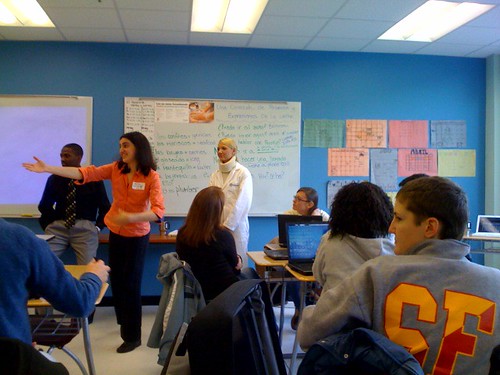 Last month I attended Educon 2.0 in Philadelphia, an “unconference” that grew out of a grass roots movement by many educators who blog and work with Web 2.0 tools. In my opinion, it was a spectacular success, not just because 250 educators showed up on a wintery weekend in Philadelphia, most on their own dime, but because of the showcase it provided for the Science Leadership Academy - especially the teachers and students.
Last month I attended Educon 2.0 in Philadelphia, an “unconference” that grew out of a grass roots movement by many educators who blog and work with Web 2.0 tools. In my opinion, it was a spectacular success, not just because 250 educators showed up on a wintery weekend in Philadelphia, most on their own dime, but because of the showcase it provided for the Science Leadership Academy - especially the teachers and students.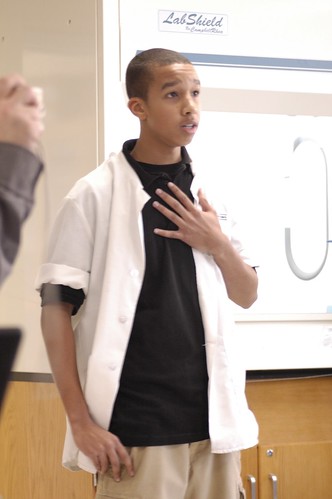 These teens waded into discussions and spoke their minds. They facilitated discussions of diverse educational issues, sharing their opinions and experiences with people they’d never met before. It’s obvious these young adults are being listened to and know they can share their voice.
These teens waded into discussions and spoke their minds. They facilitated discussions of diverse educational issues, sharing their opinions and experiences with people they’d never met before. It’s obvious these young adults are being listened to and know they can share their voice.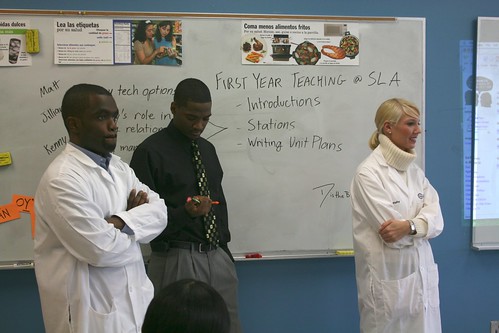 Jillian Gierke, Melissa Yarborough, Matt Kay, and Kenneth Rochester. They discussed what they learned, what they tried, what worked and what didn’t. It was a fabulous session. There is a video and handouts online, but there would be no way to capture the energy of the room as we moved to various centers, each run by one teacher who shared their classroom experiences with us. We tried our hand at designing a lesson using the Understanding by Design method, and found that 1) it was hard fun and 2) different groups came up with some really interesting yet completely different approaches.
Jillian Gierke, Melissa Yarborough, Matt Kay, and Kenneth Rochester. They discussed what they learned, what they tried, what worked and what didn’t. It was a fabulous session. There is a video and handouts online, but there would be no way to capture the energy of the room as we moved to various centers, each run by one teacher who shared their classroom experiences with us. We tried our hand at designing a lesson using the Understanding by Design method, and found that 1) it was hard fun and 2) different groups came up with some really interesting yet completely different approaches.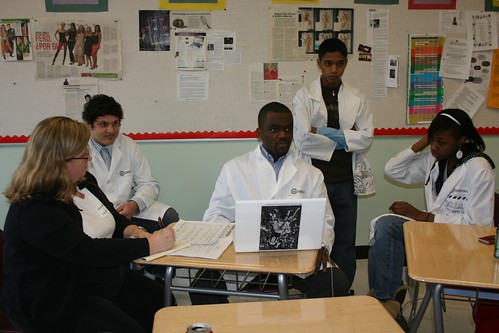 One teacher shared the lesson he learned over the year - “less is more,” he quietly said. And you could see the conviction in his eyes that this wasn’t the third bullet on a list of rules he’d been handed. He’d lived it and learned it. Another teacher shared how her ongoing discussions with other faculty shaped her classroom style, and how she planned to continue this as new faculty joined the SLA.
One teacher shared the lesson he learned over the year - “less is more,” he quietly said. And you could see the conviction in his eyes that this wasn’t the third bullet on a list of rules he’d been handed. He’d lived it and learned it. Another teacher shared how her ongoing discussions with other faculty shaped her classroom style, and how she planned to continue this as new faculty joined the SLA.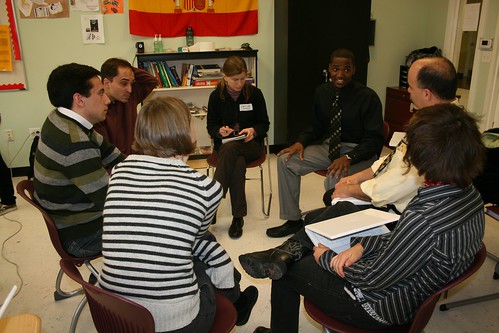 imagine being anywhere else.” The ethic of care at this school obviously includes the teachers, and that makes all the difference.
imagine being anywhere else.” The ethic of care at this school obviously includes the teachers, and that makes all the difference.
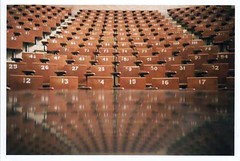






Comments
Ryan, interesting ideas. You caused some writing on my end...
http://tinyurl.com/2r3dr3
Posted by: Miguel Guhlin | February 3, 2008 2:11 PM
Miguel:
Your points are quite interesting and offer some insights into what I'm pondering.
I don't see this as a walled garden issue but as more of helping students grow their network starting from within and giving each student a learning space that isn't confined to a specific course or a specific teacher. This focuses beyond individual classes and moves it towards a systemic use of participatory media and literacy focus.
The last thing I want is a walled garden. However, I think there is a starting point where connecting locally allows us to branch off. Perhaps audience as peers makes it seem as though I'm advocating for this. However, I'm advocating for students to start local and expand.
How many students are blogging right now without a global audience? It is great to speak about the Internet in an authentic state, but there are a number of classrooms blogging and an audience is never established. By the time one begins to form, the course is over and the blog ends because it is course or grade based NOT student based.
I want all students to have the opportunity to engage globally for a sustained period. Right now, I see a few exceptional teachers doing the best they can within a limited scope: grade-level or subject-matter.
Thanks for the thoughts that I'm sure I'll continue to ponder.
Posted by: Ryan Bretag | February 3, 2008 3:44 PM
I too am struggling at the moment. I am wondering if we are shooting ourselves in the foot because we have a great number of educators testing theory without sound research.
I shouldn't even try to relate this because I just picked up the book, but your line of thinking is similar to Neil Postman's Technopoly. I stumbled upon this book through Wes Fryers NCLB post and then, in an odd occurrence, discovered the book at eye level while crossing through Borders to get to the coffee shop.
Postman provides great insight to the all or nothing line of thinking that technophiles support. He cautions that when the new is blindly looked upon as just better we fail to look at it with both eyes.
I am with you. If we just unleash students on this stuff because it is the next big thing are we losing something that will not be revealed for a decade or so?
Postman begins the book with a story from Plato's Phaedrus. There are two thoughts in this story that are eating away at me. 1. The inventor/discoverer is never the best judge of good or harm. 2. (speaking of writing) Pupils will receive a quantity of information without proper instruction, and in consequence be considered very knowledgeable when they are for the most part quiet ignorant. (access without understanding)
Are we building knowledge or breeding contempt for it? (Google will make my choices for me using an algorithm)
Sorry I did this here, but I am having one of those moments. Am I a leader or a follower? And for that matter who are leaders and does the fact they blogged first make them the authority of the future of education?
Some teachers are working hard to make sure HOTS are part of the experience, but what about the vast majority?
I need to regroup.
Posted by: Ken Pruitt | February 4, 2008 2:36 PM
Your point is well made and I agree... maybe I am missing somethings as I read your message and Mighuels response.
1. Doesn't everything go back to the school's and teacher's purpose, goals, and objectives. Ask why you want to have your learners collaborate and you will find where you need to start!
2. Can't you list a dozen school activities that lack congruence across grade levels. We ask our k - 12 teachers to meet once or twice a year to align curriculum?
3. Once you can define what the purpose and ultimate goal of our public education system is, than we can finally begin to address your point more fully. Are we trying to get them into college? Are we focused on a basic set of knowledge standards? Are we preparing them for the 21st century? Are we trying to help them become life long learners? Are we trying to get them to be active citizens of our country? Are we focused on behavior? Is it to learn how to pass the test?
Interesting quick reads I found in 2 minute Google Search:
http://www.berkeleydailyplanet.com/article.cfm?storyID=6906
http://nhs.needham.k12.ma.us/Menu/statement.htm
Posted by: Scott Meech | February 4, 2008 6:36 PM
Hey Scott:
Thanks for the comment. Since you've laid out your thoughts by points, I'll respond in a similar fashion :-)
1. Of course, it does come back to and should come back to what we are attempting to accomplish. Obviously, there is extensive research in the area of collaboration, so I'll simplify this a bit that it is considered a best practice.
Because of that, I want collaboration occurring with great breadth and depth allowing for those global connections to foster growth on a local level. As Reich and Solomon say, "you must make sure they are tapped into the world and the local community, so that the changes and differences that result from being connected to people all over the globe are integrated into what you do at local and global levels."
2. I sure can but there is two issues here: 1. cultures of isolation must be removed in schools 2. I see this as more than just an activity. In fact, this is what I want to move away from: today, we are doing a collaborative activity. I don't want collaboration, connecting, and networking to be an anomaly but what we do day in and day out as learners.
With today's tools, this should be easier to accomplish for teachers, departments, and schools. Again, the research is vast in the area of professional learning communities yet many are still not embracing this concept or have embraced it on a surface level.
In some sense, I would say because of your comments I feel it is even more important to build this foundation locally if we want to see all learners experiencing a glocal (boy, I'm butchering this term) learning environment.
3. Not to heavy of a question, eh :-)
Seriously though, since most mission statements around the country encompass pieces of each of your questions, I'm sure we could package it up in a nice, cohesive statement.
But, like intended vs. taught curriculum, I wonder if the intended mission of many schools is truly lived out in each and every decision made within schools.
Posted by: Ryan Bretag | February 5, 2008 2:01 AM
Wow! Thanks for the comment Ken. I must admit that I've never read anything by Postman but you have me intrigued.
Based upon the questions and thoughts in your comment, I know I've missed something well worth reading, so I'll hold a bit on my thoughts until I've read this piece.
Thanks for getting the wheels spinning!!
Posted by: Ryan Bretag | February 5, 2008 2:06 AM
Ryan-
I was just having a conversation with Scott Meech and a few other educators about the value of Ed.Voicethread in comparison to having a teacher use a pro voicethread acct with students using sub-identities.
Ed.Voicethread is a great solution for students to carry a digital suitcase and create a digital learning trail over time. It is a bummer that it doesn't allow authentic comments from people who will never be able to have an Ed.Voicethread account, but I'll take the upside.
We have the same thing with blogs. Some teachers have their kids use blogger for a history blog, some english teachers then have the students use blogger to create a separate english blog. We need one platform in our school so students can blog across different classes and across many years.
Definitely a timely post as I've been thinking about these same challenges, Ryan.
Thanks,
Matt
Posted by: matt montagne | February 11, 2008 4:04 AM
I love your concept: "Golcal"
Yes, I believe it is very important to "Think Globally, and Act Locally". I can see how new technology, such as blogging can help. This new culture has the opportunity to build bridges across the globe and allow communication between cultures like never before. Making connections at the local level with the school community is a start in bringing us all closer at the global level. This is as you said a "collaborative culture" and educators need to help generate more interest in using new technologies to enhance the learning environment.
jmv
Posted by: jmv | February 12, 2008 7:02 AM